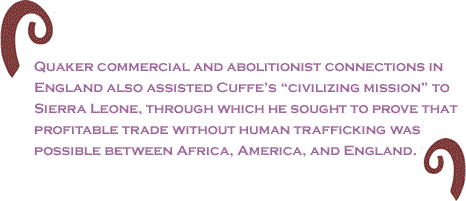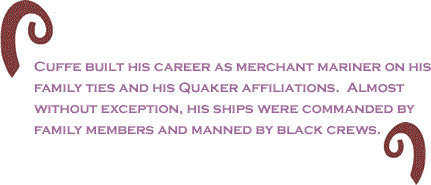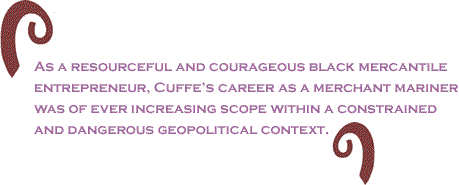|
|
| |
|
| |
|
| |
|
| |
|
| |
|
| |
Born
to a self-emancipated African father and a Wampanoag
mother on Cuttyhunk Island in 1759, Paul Cuffe lived
most of his life on land in the village of Westport,
Massachusetts. In his youth when he appealed to the
Massachusetts legislature for voting rights as a tax
payer, he claimed his Indian heritage; in later life
he emphasized his African identity. Paul Cuffe’s contemporaries
described him as “a man of noble personal appearance,
tall, portly, and dignified in his bearing.“ [i] At the time of his death in 1817, Paul Cuffe
probably was the most famous African American on both
sides of the Atlantic. Cuffe’s fame derived from his
prowess as a merchant mariner, his entrepreneurial enterprises
on land, and his philanthropy at home and abroad. He
was a man of extraordinary personal and social courage,
a life-long risk-taker, a resourceful and resolute entrepreneur,
a skillful and indefatigable networker, the patriarch
of an extended family, and an exponent of the Quaker
virtues of honesty, thrift, truthfulness, reliability,
and hard work. [ii]
Resourceful Entrepreneur: Kinship, Community, and Religious
Networks
As a resourceful and courageous black mercantile entrepreneur,
Cuffe’s career as a merchant mariner was of ever increasing
scope within a constrained and dangerous geopolitical
context. When he began trading between Westport and
Nantucket in 1779, slavery was legal in the American
colonies and continued to be legal in southern states
throughout his career. Until 1807 the transatlantic
slave trade was legal and continued illegally throughout
his life. Ships with black crews were liable to be
seized and their crews sold into slavery. More than
once Cuffe’s ships evaded capture by foreign vessels.
Yet Cuffe sailed from Maine to Georgia, from Savannah
to Sweden, from Westport to the West Indies and to West
Africa armed with appropriate documents, well- maintained
vessels, and disciplined crews. It took great personal
courage and resolve to venture confidently around the
Atlantic Ocean world as Cuffe did. Moreover, stormy
relationships between England and France and the United
States impeded opportunities to pursue his transatlantic
maritime ventures—in 1806, for example, his ship was
delayed for three months in Savannah due to a French
blockade; in 1808 and during the war of 1812, the United
States placed an embargo on trade with England. In
fact, when the Traveller returned from the British
colony of Sierra Leone in 1812, she was impounded in
Newport until Cuffe secured the release of his ship
with its African cargo.
Paul Cuffe achieved his entrepreneurial
success by resourcefully maximizing social networks
based on kinship, community, and religious affiliations.
Cuffe built his career as merchant mariner on his family
ties and his Quaker affiliations. Almost without exception,
his ships were commanded by family members and manned
by black crews. In his maritime endeavors, Cuffe’s
most important partners were his brother-in-law, Michael
Wainer, and Michael Wainer’s sons. Michael Wainer became
 Cuffe’s
first major business partner as Cuffe began to trade
along the Atlantic coast and to buy ever larger boats
in the 1780s but retired to farm in 1800. Michael’s
eldest son Thomas became first mate of Cuffe’s ship
the Alpha on its 1806 coastal and transatlantic
voyages; he captained other Cuffe ships including the
Hero on her voyage to Portugal and Spain, the
Ranger on the coastal trade route, and the Traveller
on her voyage to Sierra Leone in 1810-12. Paul
Wainer shipped on the 1806 whaling voyage of Hero
as mate and keeper of the log and Cuffe appointed
him captain of the Traveller in 1815. Jeremiah
Wainer captained the Ranger on her coastal trading
voyages from 1801 until his death at sea in 1805. John
Wainer served as first mate on the Traveller’s
first voyage to Sierra Leone. Cuffe’s own sons, Paul
and William, who were at least a decade younger than
their youngest Wainer cousins, joined crews on their
father’s ships later in his career. The centrality
of kinsmen in Cuffe’s maritime endeavors is reflected
in the fact that of the seven crew members on the 1815
voyage to Sierra Leone only one was not a relative of
Captain Cuffe. Cuffe’s
first major business partner as Cuffe began to trade
along the Atlantic coast and to buy ever larger boats
in the 1780s but retired to farm in 1800. Michael’s
eldest son Thomas became first mate of Cuffe’s ship
the Alpha on its 1806 coastal and transatlantic
voyages; he captained other Cuffe ships including the
Hero on her voyage to Portugal and Spain, the
Ranger on the coastal trade route, and the Traveller
on her voyage to Sierra Leone in 1810-12. Paul
Wainer shipped on the 1806 whaling voyage of Hero
as mate and keeper of the log and Cuffe appointed
him captain of the Traveller in 1815. Jeremiah
Wainer captained the Ranger on her coastal trading
voyages from 1801 until his death at sea in 1805. John
Wainer served as first mate on the Traveller’s
first voyage to Sierra Leone. Cuffe’s own sons, Paul
and William, who were at least a decade younger than
their youngest Wainer cousins, joined crews on their
father’s ships later in his career. The centrality
of kinsmen in Cuffe’s maritime endeavors is reflected
in the fact that of the seven crew members on the 1815
voyage to Sierra Leone only one was not a relative of
Captain Cuffe.
In his 1839 memoir, Paul Cuffe,
Jr. remembered his first voyage in 1806 with his father,
providing a fascinating glimpse of the rhythms and challenges
of commercial trading:
… with the novelty attending a sea voyage I was highly pleased.
Nothing uncommon attended this voyage… to Pasamaquaddy,
for Plaster of Paris. We made this voyage down in about
10 days. After loading our vessel, which took two weeks,
we again set sail for Wilmington,… at which port we
safely arrived in 16 days, discharged our freight, took
in ballast and 300 bushels of apples, and sailed for
Savannah,… where we arrived …in about twenty days, where
we again discharged our freight and reloaded our vessel
with Cotton, Rice, and Logwood. Here we lay three months
in making preparation for sea again. From this place
we made out into the broad Atlantic… This was a long,
tedious voyage,…we sailed a great number of days in
a northward direction, until we made the Grand Banks;
then we steered away for the northern coast of Scotland,
which we reached in about fifty days. Thence we continued
our course… into the Northern Sea, and made the entrance
to the Baltic…thence along the coast of Copenhagen to
Gottenburgh…Here we lay six weeks, sold our lading,
and took in a load of iron, steel and hemp. From thence
we sailed for Elsinore…where we took in a number of
passengers for Philadelphia, at which place we arrived
after a long passage….During this voyage we had much
rough weather;… we were compelled to throw overboard
fifty tons of iron while on the Grand Banks. During
this gale we lost our fore-top-mast, jib-boom and long
boat. [iii]
On land, Cuffe invested in enterprises
that were ancillary to his primary maritime trading
interests. He partnered with family members to build
his ships, to run his grist mill, and to farm his land
in Westport and opened a West Indian import store in
New Bedford with two sons-in-law. He also partnered
with white Quaker neighbors to build ships and to engage
in commercial ventures.
Over the years of his mercantile
career Cuffe owned numerous ships. He also built four
in his Westport shipyard between 1796 and 1807: the
Ranger, a 60-ton, square sterned schooner; the
162-ton brig Hero; the 268-ton Alpha;
and the 109-ton brig Traveller. In addition to
his relatives, Cuffe employed white craftsmen to assist
in ship building and repairing.
[iv] Apart from the Traveller, Cuffe also
shared ownership with relatives and white Westporters.
In 1804, Cuffe owned the Ranger jointly with
his nephews, Michael and Jeremiah Wainer; the Hero
was owned ¼ by white Westporter Isaac Cory and his
son; ¼ by Thomas Wainer, and ½ by Paul Cuffe; the Alpha
initially was owned ¾ by Paul Cuffe and ¼ by his
Quaker neighbor Lemuel Milk and later was co-owned with
Philadelphia Quaker, John James, who bought Cuffe’s
share in the ship for $6,500 in 1815. Although Cuffe
often had co-owners for his ships, he always maintained
a controlling interest of at least 50% in his vessels.
The one exception to this policy occurred in 1806 when
three white merchant mariners from the neighboring town
of Dartmouth invited Cuffe to invest in their schooner,
Hope, which traded on the New Bedford to Philadelphia
run. [v]
Cuffe’s Quaker connections gave
him entrée to distant markets along the Atlantic coasts
in the United States, in Europe, and in West Africa.
Many of his Westport neighbors were Quakers and Cuffe
joined their meeting in 1808. The wealthy Rotch family,
Quaker founders of New Bedford, probably knew Cuffe
from his earliest trading ventures between Westport
and Nantucket and provided him with entrée to other
affluent Quaker merchants in Providence and Philadelphia.
Quaker commercial and abolitionist connections in England
also assisted Cuffe’s “civilizing mission” to Sierra
Leone, through which he sought to prove that profitable
trade without human trafficking was possible between
Africa, America, and England.

In times of trouble Cuffe enlisted
the assistance of his Quaker network in America and
in England. When customs officials impounded the Traveller
in Newport on its return from Sierra Leone in 1812,
Cuffe immediately mobilized his Quaker network in Newport,
New Bedford, Providence, and Philadelphia—gathering
letters of support for the release of his brig and her
African cargo from the U.S. District Attorney in Newport,
the past Collector of Customs in Newport, the Governor
of Rhode Island, a U.S. senator, the former speaker
of the U.S. House of Representatives as well as from
prominent Quaker merchants—William Rotch, Jr. in New
Bedford, Thomas Arnold and Moses Brown in Providence,
and John James in Philadelphia. John James introduced
Cuffe to Samuel Hutchinson with whom Cuffe stayed in
Washington and who accompanied Cuffe to his meetings
first with President Madison and then with the Secretary
of the Treasury. The Secretary agreed that Cuffe’s
ship and his cargo would be restored to him. In two
weeks time, Cuffe had traveled overland by stage from
Newport to Washington and successfully persuaded the
president and his secretary to release Cuffe’s ship,
thanks to both his own resoluteness and his judicious
use of Quaker connections. Although the release of
the Traveller is perhaps the most dramatic example
of Cuffe’s resourceful use of his Quaker network to
resolve concerns, several others are recorded in his
letters over the years.
[vi]
During his lifetime Paul Cuffe experienced
not only considerable financial success ut also considerable
financial distress. His first voyage to Maryland brought
him a $1,000 cargo of corn for the New Bedford market;
an 18-month whaling voyage to southeast African waters
netted Cuffe a profit of $1,700, but the War of 1812
inhibited his commercial ventures and he took an $8,000
loss on his 1815 voyage to Sierra Leone, because he
paid the passage of most of the 38 African American
settlers and he met severe trading restrictions in the
colony. Cuffe achieved a reputation as a resourceful,
respected, and reliable business man not only in his
home community of Westport but elsewhere in the Atlantic
World.
With the profits garnered from his
maritime ventures in trading and whaling Cuffe invested
in real estate and commercial projects in Westport.
His first real estate purchase was a small 35 rod-parcel
on the Westport River in 1789 for 4L 18 shillings;
his second in 1799 was 40 acres in the same area for
$1,000 and his third was the 100 acre homestead farm
of Ebenezer Eddy for $2,500. In 1800, he and two black
neighbors purchased a windmill on Westport Point for
$120 to grist grain brought in his ships from mid-Atlantic
states. In the last months of his life, he signed a
contract with Quaker Joseph Tripp to establish a salt
works. Between 1809-1816 Cuffe also invested and traded
in real estate: Cuffe joined two white Quakers in purchasing
several tracts of land including a cedar swamp, two
salt marshes, and two farms for $6,890 which they traded
back to the original owner the following year; Cuffe
and Michael Wainer bought a salt marsh for $210; Cuffe
xpended $13,000 to add open land, a salt meadow and
two farms to his personal holdings. Not only did Cuffe
purchase real estate but he loaned money to Westport
neighbors and took mortgages on their land as security.
For example, in 1812, he loaned Nathaniel Sowle $158.76;
the loan was secured by a mortgage on 31 acres of land
and repaid on time. In 1814, he loaned Burnea Devoll
$600 payable in four years and secured by a mortgage
on 48 acres. While he provided mortgages for loans
to Westport neighbors, the prudent Cuffe never mortgaged
any of his own land.
Cuffe’s Probate Records and Social Networks
When Paul Cuffe’s will was entered
in the Bristol County Probate Court in 1817, the cord
of the will took four long pages and the inventory of
his real and personal estates another eight. The total
value of the estate was approximately $20,000—the equivalent
of $322,000 today.

Paul Cuffe’s probate records reveal the importance of his
commercial networks and his concern for the well-being
of his family and his church. The witnesses, appraisers,
and executors of the will were white Westport and New
Bedford business associates and friends. Cuffe’s role
as family patriarch is expressed most fully in his will.
His will distributes real and personal property first
to his wife Alice, his children, his grandchildren,
his siblings, some of his in-laws and cousins, and then
to the Westport Society of Friends. He further specifies
his unmarried daughters’ rights to live in their mother’s
house before and after her death as long as they are
unmarried. To his beloved wife he left all his household
goods except two desks, a bookcase, and his books; he
also left her their dwelling house, one half of all
his lands and livestock, and all the family provisions
on hand, one hundred dollars, and all the profits from
his salt works or $100 annually should the salt works
fail. He left to his daughter Mary Phelps another
house and land; to his son Paul his maple desk and half
his clothing, the farm that he had inherited from his
father, $500 to be invested and the income used for
the support of Paul’s family and a 25% share in the
brig Traveller; to his son William he gave another
plot of land of c. 40 acres and $300 to build a house
on the land, a 25% share in the brig Traveller,
his walnut desk and book case, his dictionary, and
50% of his clothing; to his four other daughters he
left each a 1/8 interest in the Traveller, and
to his two orphaned granddaughters, he left each $50
to be given to them when they became 21 years old. To
his siblings and a few “cousins”, he gave $10 outright
or $ 6 annually, though “should they…make bad use of
the money…I request my executors to pay them in provision
or cloathing, and such things that may be for their
comfort.” Any residue of his estate was to be divided
equally among his six living children, though his executors
were instructed to retain sufficient funds to ensure
that the annual payments mentioned in the will could
be made.
In addition to his family Paul Cuffe remembered the Society
of Friends in Westport, leaving fifty dollars to “be
paid over to their treasurer, by my executors, according
to the direction of the monthly meeting.” Cuffe’s parents
are said to have adhered to Quaker principles though
they were not Quakers. Cuffe joined the Westport Meeting
and assumed Quaker dress in 1808. He obtained traveling
letters from the Meeting before embarking on his voyages
to Sierra Leone and his trip to Washington to meet with
President Madison. He contributed his services to the
Meeting as an active member of various financial, investigative,
and building committees and as the principal financial
contributor to the building in 1813 of the sparely elegant
Meeting House in the graveyard of which Paul Cuffe and
his wife are buried.
Paul Cuffe’s will reveals that he had considerable durable
property, that the well-being of his immediate and extended
family and his church were his primary concerns, and
that he was a careful and insightful planner for their
future prosperity.

The inventory of Cuffe’s estate discloses his complex relationships with Westport
neighbors, his commercial interests, and his personal
acquisitions. His real estate included not only the
land and buildings mentioned but a six-acre woodlot,
two meadows, and a cedar swamp. The total value of
his real estate was assessed at $4,119. The most valuable
item in his personal estate was the brig Traveller,
assessed at $1,800, the next was his share of the salt
works on Joseph Tripp’s land $800, then there were the
thirty-three notes and obligations, primarily mortgages
on land, that were owed to his estate by black and white
Westport residents that totaled approximately $4,158
and revealed a web of obligation among kin and neighbors
to one of the most affluent members of the Westport
community. The inventory of his numerous possessions
discloses traces of his entrepreneurial endeavors as
merchant mariner, shipbuilder, and farmer. Among the
items assessed are iron hoops, old rigging, charts,
fish hooks, whale lancets, half pint French tumblers,
African peppers, casks of varnish, timbers and boards,
saws and planes, scythes and plough shares, oxen, hens
and lambs. His household items included a large looking
glass, 6 Windsor chairs, trunks and chests, beds, bolsters,
pillows, quilts, sheets, large plates and small plates,
pitchers and teapots, cream pots and sugar bowls, skillets
and kettles, knives and forks. His wearing apparel
that was to be divided between his two sons was also
itemized. Finally there is his library of
books that this self-educated man treasured—his Bible,
his two-volume dictionary, a concordance, as well as
books and pamphlets on history, art, and other topics.
His appraisers assessed his personal property as totaling
$14,022.57. They also noted additional obligations
owed to him in Sierra Leone. Perhaps the appraisers
did not enter these obligations in their summation,
because they thought that they were less likely to be
met than those closer to hand in Westport. Paul Cuffe’s
will and the inventory of his estate reveal aspects
of his life concerns and achievements but fail to convey
the full texture of his remarkable life journey.
Conclusion
Paul Cuffe achieved his entrepreneurial
success through his effective mobilization of members
not only of his extended Afro-Indian family but of his
religious community within Westport and across the Atlantic
world. But as remarkable as that ability was, even
more significant was the philosophy that underlay his
prudent, shrewd, courageous, and resourceful business
acumen. At the end of an 1816 letter to a fellow merchant
mariner, he appended this “watch word”:
In experience I have ever found when I attended to my business
I seldom suffered loss. I have found it to be good to
make choice of good companions. I have ever found it
not to be profitable for me to sit long after dining
and make a tipling habit of wine and other liquors.
These very people who adopt these practi[ce]s when they
see a sober steady man, they will put business in his
way. [vii]
Paul Cuffe became a model of integrity and entrepreneurial success not only
in his own time but in ours. And so we honor the continuing
salience of his achievements today.

BlackCommentator.com Guest Commentator Dr.
Marion Kilson, received her Ph. D. in Social Anthropology
from Harvard University in 1967 and retired
as Dean of the Graduate School at Salem State
College (MA) in 2001. A collection of her anthropological
essays, Dancing with the Gods: Essays in Ga Ritual,
will be published later in 2012.
Click here to contact Dr. Marion Kilson.
[ii] Cuffe articulated his precepts for living
in an 1816 letter of advice to his nephew Thomas Wainer:
“See to this before it is too late: Look about thyself—awake
to industry, deal honestly, live frugally, and…prohibit
thyself from unnecessary expenses. I am a member of
the Society that are combined for the purpose of discouraging
intemperance, therefore, I take he liberty of inquiring
of thee whether thou makes use of intoxicating liquors—if
so, my candid advice toyou is to take up a firm resolution
and leave off making any kind of use of them unless
for sickness. Confine thyself at home. Understand me
all business must be attended to, but do not go after
strange flesh; love mercy, walk humbly, and fear God.
Observe the above advice and I believe thee will get
along well and be comfortable here and be happy hereafter.
(Wiggins:485-6)
[iii] Cuffe, Jr:3-4. Paul Cuffe, Jr. erroneously
states that this voyage took place in 1808.
[iv] For example, the account book of David Lake,
a white carpenter from iverton, RI shows that Cuffe
paid Lake for repairing the Ranger in 1806 with
cash, sugar, and lottery tickets. (David Lake Account
Book, 1805-07, Rhode Island Historical Society Library,
MS.
[v] Principal sources of information: Thomas,
passim; Loomis, Chapter 3, and Putney, “Pardon
Cook…”, 47-54.
[vi] In 1811, when the British Navy tried to press
into service Cuffe’s young African apprentice into service
in Liverpool, Cuffe enlisted prominent Quaker merchants
and abolitionists to write to the Admiralty for the
young man’s release. Cuffe traveled to London where
he went with famed Quaker abolitionist Thomas Clarkson
to the Admiralty. There he discovered that the youth’s
release had already been ordered. (Sherwood:174-176)
[vii] Wiggins: 467.
Bibliography
--------The
History of Prince Lee Boo, to which is added, The Life
of Paul Cuffee, A Man of Colour, also, the account
of John Sackhouse, the Esquimaux. (Dublin: C. Crookes,
1820).
Allinson,
W. J., “A Brief Memoir of Paul Cuffee,” The Non-Slaveholder
V, 12 (1850): 265-269, Armistead, Winston. Memoir
of Paul Cuffe, A Man of Color. (London: Edmund Fry,
1840).
Bristol
County Probate and Family Court Paul Cuffe’s Probate
Records
Cordeiro,
Brock N. “Paul Cuffe: A Study of His Life and the Status
of His Legacy in ‘Old Dartmouth,” (UMB-MA History Thesis,
2004).
Cuffe,
Paul, [Jr]. Narrative of the Life and Adventures
of Paul Cuffe[Jr.], A Pequot Indian. [1839] (Westport,
MA: Cuffee’s Bookcase, 1979).
Dartmouth
Town Records, 1814-1815.
Devlin,
Edward W. A Man Born on Purpose: Captain Paul Cuffe
of Westport. (Westport Historical Society, 1997.
Devlin,
T. “The Search for Cuffe’s Windmill,” (MS, Westport
Friends Meeting House, n.d.).
Diamond,
Arthur. Paul Cuffe. (New York: Chelsea House
Publishers, 1989).
Farr,
James. “A Slow Boat to Nowhere: The Multi-Racial Crews
of the American Whaling Industry,” Journal of Negro
History 68, 2 (Spring 1983):159-170.
Grover,
Kathryn. The Fugitive’s Gibraltar: Escaping Slaves
and Abolitionists in New Bedford, Massachusetts. (Amherst:
U. Mass. Press, 2001).
Harris,
Sheldon H. “An American’s Impressions of Sierra Leone
in 1811,” Journal of Negro History 47, 1(Jan.
1962):35-41.
Howard,
H. P. A Self-Made Man, Capt. Paul Cuffe (1913)
Kaplan,
Sidney. The Black Presence in the Era of the
American Revolution, 1770-1800. (Washington, D.C.:
Smithsonian Institution, 1973).
Lewis,
Harold D. “Cuffe, Paul,” in Rayford W. Logan and Michael
R. Winston (eds.) Dictionary of American Negro Biography.
(NY: W. W. Norton & Co., 1982), pp.147-148.
Loomis,
Sally. “Captain Paul Cuffe (1759-1817) and His Work,”
MS, nd.
Malloy,
Mary. “From Boston Harbor We Set Sail”:
A Curriculum Unit on African-American Mariners And Maritime
Communities in Massachusetts. (Sharon, MA: Kendall
Whaling Museum, 2001).
McKissack,
Patricia C. and Frederick L. McKissack, Black
Hands, White Sails: The Story of African-American
Whalers. (NY: Scholastic Press, 1999).
National
Archives and Records Administration, Waltham, MA
Manifest for Traveller and Crew List, 1810 voyage to
Sierra Leone
New
Bedford Free Public Library Disbursement on Brig Traveller—bill
of stores/Act. Sales Cargo of Brig Traveller—1817, Cuffe
Reel
1: 458, 458
Manifest for Ranger, Cuffe Reel 1:191.
New Bedford Store: cost of goods sold, Cuffe Reel 1:485.
Putney,
Martha S. “Richard Johnson: An Early Effort in Black
Enterprise,” Negro History Bulletin 45
(April-June 1982): 46-47.
-------“Pardon
Cook, Whaling Master,” Journal of Afro-American Historical
and Genealogical Society (Summer 1983): 47-54.
-------Black
Sailors: Afro-American Merchant Seamen and Whalemen
Prior to the Civil War. (NY: Greenwood Press, 1987).
Rhode
Island Historical Society Library
Francis family of Providence and Warwick, R.I. MS426
David Lake Account Book, 1805-07, MS.
Ricketson,
Daniel. The History of New Bedford. (New Bedford,
1858).
Salvador,
George Arnold. Paul Cuffe, The Black Yankee, 1759-1817.
(New Bedford: Reynolds-DeWalt Printing, Inc., 1969.
Sherwood,
H. N.“Paul Cuffe,” The Journal of Negro History
, VIII,3 (April 1923): 153-229.
Thomas,
Lamont D. Rise to Be a People: A Biography of Paul
Cuffe. (Urbana: University of Illinois Press, 1986.
Town
of Westport
Paul
Cuffe’s tax records for 1807, 1808, 1811, 1813, 814,1815,
1817
Vital
Records of Westport, Massachusetts to the year 1850.
Westport
Quaker Meeting House
Document:
Agreement between Paul Cuffe and Joseph Tripp to establish
salt works, dated April 21, 1817.
Wiggins,
Rosalind Cobb. Captain Paul Cuffe’s Logs and Letter,
1808-1817: A Black Quaker’s “Voice from within the Veil.”
(Washington, D.C., Howard University Press, 1996).
Woodson,
C. G. “The Relations of Negroes and Indians of Massachusetts,”
Journal of Negro History 5,1 (Jan. 1920):45-57.
|
| |
|
| |
|
| |
|
| |
|
| |
|
If you send
us an emaill message we may publish all or part
of it, unless you tell us it is not for publication.
You may also request that we withhold your name.
Thank you
very much for your readership.
|
| |
|
| |
|
| |
|
| Feb 9, 2012 - Issue 458 |
 is
published every Thursday
is
published every Thursday |
| Est. April 5, 2002 |
Executive Editor:
David A. Love, JD |
Managing Editor:
Nancy Littlefield, MBA |
Publisher:
Peter Gamble |
| |
|
|
| |
|
|
|
| |
| |
| |
| |
| |
| |
| |
| |
| |
| |
|
|

